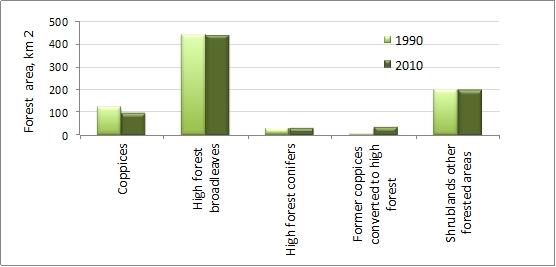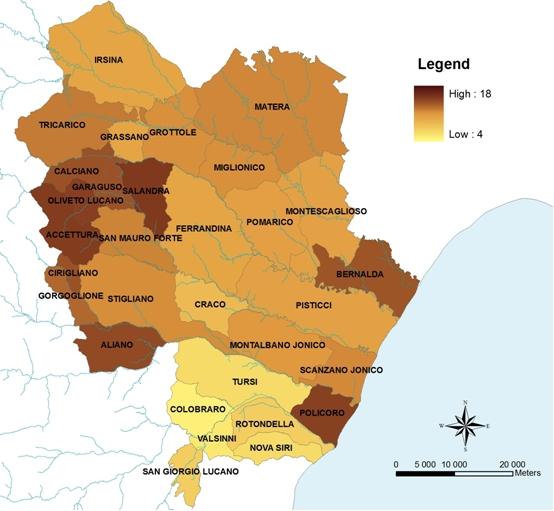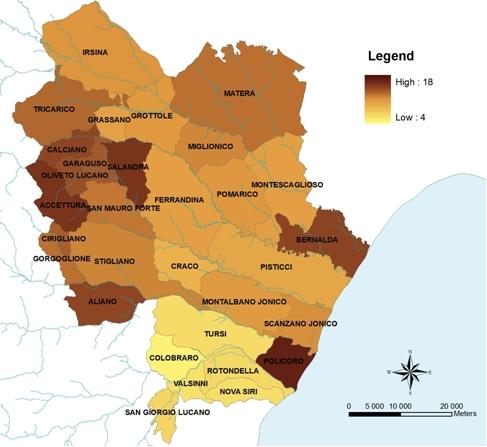Study sites in cropland
Study sites in grazing land
Study sites in forests
Sustainable forest management period (1990 to date)
| Authors: | Angelo Nolè, Guiseppe Mancino, Luca Salvati, Francesco Ripullone, Agostino Ferrara |
| Coordinating authors: | Agostino Ferrara, Giovanni Quaranta, Rosanna Salvia |
| Editor: | Alexandros Kandelapas, Jane Brandt |
Editor's note 23Mar14: Source D332-2.2.2
Assessment of natural, economic and social capitals
| Natural capital | |
| Assessment | Climate capital during this period is moderate-low. The data confirms the gradient towards the south eastern part of the study site with a slight decreasing severity in the climate aridity conditions. Soil capital remains stable. The spatial distribution and values of the vegetation are the same as in the last period but there is a generalized improvement due mainly to: vegetation recolonization processes, afforestation projects implemented in the area; and the conversion of large areas of coppices into high forests. This last is an important aspect of the new sustainable forest management approach.
The water capital component exhibits a slight increase in the average values, related to the increase of forest cover over the study site |
| Critical functions | Most municipalities have high regulation of hydrological processes with generalized decreasing rates of runoff in all the Matera study site forests. Primary production (in terms of mean productivity) generally increases except in municipalities with more severe soil and climatic conditions.
Biodiversity conservation shows a substantial improvement in all indicators (increase in total area under protection, Naturality index, Pielou's index). These observations are confirmed also by the increase of forest productivity and forest surface. |
| Critical variables | Natural capital is characterized by slow changes in this second period. There is a slight decrease in climate severity, a trend that is positively connected to changes in vegetation capital components, the recolonization processes and biodiversity conservation. As expected, the slowest capital component in the system is soil. |
| Economic capital | |
| Assessment | In general, the trend towards both bigger and smaller farms continues. There is also a decrease in rural woodlands Variations in employment in different sectors confirm the continuation of trends of the previous period: slight decrease in industry, notable increases in services and the silviculture sectors.
Road connections remain relatively stable. Availability of agricultural machinery increases, following higher rates of investment in the agricultural sector. Animal capital confirms different dynamics between different areas despite an overall reduction. The slight decrease in livestock density and easing of environmental pressures continue to be observed in mountain and upland forested municipalities which see an increase in their plant capital. Forest fires along the coastal areas slightly diminish plant capital there. |
| Critical functions | - |
| Critical variables | The components of economic capital that show higher changes are decreasing employment in the primary sector and increasing employment in the tertiary sector, attributed to progressive suburbanization. A certain dynamic is shown by the agricultural surface per farm and the farm size with a general a reduction of these internal dynamics mainly due to different land abandonment rates. |
| Social capital | |
| Assessment | Population changes along the coastal-inland gradient with ageing and an increase in foreign citizens, mainly in the coastal areas (related to agricultural and tourism activities) and in the urban area of Matera continue. Data confirm depopulation and land abandonment for inland areas, with even more critical values in some mountain and remote municipalities.
Human capital shows a general increase in the average educational level of the resident population. The increase can be considered spatially homogeneous and particularly dependent on the number of secondary school graduates and university graduates (mainly due to the effects of the establishment of the University of Basilicata in Potenza and Matera and its attractive power). There is a further increase of buildings in the city of Matera and along the coastal zone as well as improvements in their quality, reinforcing the previous observations on population growth and quality standards in the municipalities. The attractiveness of the capital city (Matera) and the institution of the industrial park (Pisticci) are clearly evident. Cultural and institutional capital continues to strengthen in the role they play in the awareness of identity of the local population. |
| Critical functions | - |
| Critical variables | In general, social capital shows important changes. Improvement in levels of education is particularly high with further positive effects on the capability to better provide responses to the changes of the other SES components. In particular, the most relevant demographic processes relate to continuing internal migration toward the coast and the larger towns. Other important processes are the generalized ageing of the population and the general increase of the density of foreign citizens.
The institutional and cultural components show different trends: institutional components incorporate changes related to the transfer of competences from the central state to the regions and implement most of the policies related to forest, environment, soil management and water protection. Other components that have a valuable dynamic are those related to the tourism pressure over the coastal areas and, with higher rates, to forest fires.
|
Main LEDD problems and responses
Decline in forest productivity remains a key LEDD problem due to its connections with other critical functions such as regulation of hydrological processes and biodiversity conservation. There is slightly increase in levels of forest productivity and cover expansion that epresents a positive aspect of the resistance to external disturbances.
Loss in biodiversity and forest fragmentation, though rampant in the past, have now been reversed due to the land abandonment processes and the subsequent reduction of human pressure on the environment. There is a slow but increasing rate of recovery in forest cover through the natural expansion of the forests and an increase in biodiversity levels due to more sustainable use of the forest resources.
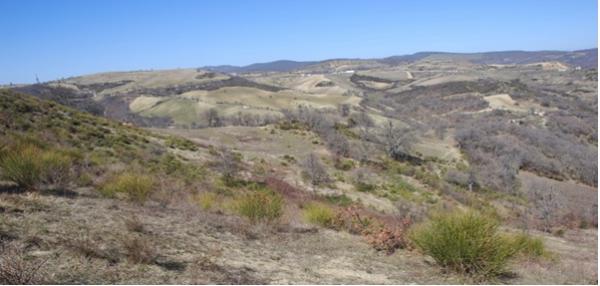
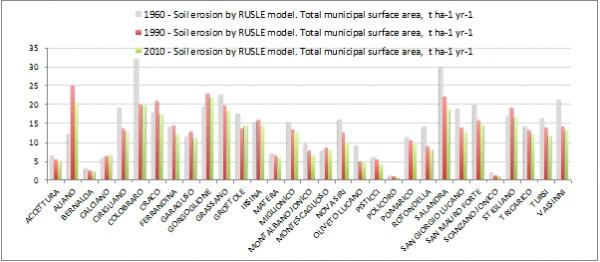
Soil erosion and deterioration emerge as a major issue of LEDD with the area showing medium-high rates of soil erosion depending on site-specific characteristics and vegetation cover. There is a decrease in estimated soil erosion level for the forested areas and improved environmental conditions of the forests. The level of resistance to water stress is stable over time both in forests and at large.
The main responses associated with problems iare the following:
- Forest fires (negative, unplanned)
- Overgrazing (negative, unplanned)
- Population dynamics coupled with land abandonment (negative in the short period/positive in the long, unplanned)
- New forest and environmental policies (positive effects in the period, planned)
- Sustainable forest management (positive, planned)
Also in this period, climate and its change continue to be a key factor for natural and semi-natural environments influencing not only biophysical aspects of the SES but constraining management options at the local scale.
These responses are similar to those of the first period, albeit with significant improvement in the effectiveness of the environmental policies. Population dynamics consolidate the urban-rural and coastal-inland density gradients observed earlier. Population increase in coastal areas and around Matera and the increase of the land abandonment of inland areas, show similar trends and consequences as before. Other disturbances include forest fires, overgrazing and negative impacts on coastal forests due to increase of tourism and second-home construction.
Forest and environmental policies and sustainable forest management emerge as a dominant response, implemented primarily through forest management plans. FMPs produced substantial positive impacts especially in drought prone areas, increasing the robustness of the SES. The enforcement of regional forest policies and measures, as well as other social intervention and policies (i.e. the foundation of the University of Basilicata Region), improve the general context of knowledge and environmental awareness and substantially improve the level and the quality of the forest and environment management and planning.
Policy context
AK: to check that implementation, impacts and effectiveness of selected policies are discussed in this text. Look at D342 to see if there is any additional information.
Progressive enforcement of administrative organization after the Constitutional reform takes hold and expands to forest policy and other environment policies, both at national and regional level. Regional forest protection policies represent a key response to LEDD in forest and/shrubland ecosystems with an effective positive change in the forest management and planning and in environmental protection. Financing for these policies, helps increase employment levels in the agriculture sector and in plant and vegetation capitals (positive responses). The implementation of nature protection, soil protection and horizontal policies is expected to gradually generate positive impacts.
A specific positive response to LEDD in the forest sector is the institution of Basilicata University in the 1982 with courses in Soil and Forest Sciences. The university positively impacts on the human capital but is, in itself, an effective response to LEDD.
Other CAP and development policy instruments have more adverse effects: tourism expansion has negative impacts in coastal forest areas as have CAP policies that continue to support cereal production and the conversion of marginal shrub areas to cereal cultivation, thereby increasing soil erosion and degradation processes.
Properties of the system
AK: to check if there is any further relevant information in D333
Natural capital: Robustness of natural capital is stable. The diversity of natural capital generally increases. Redundancy follows the trends of the previous period. Connectedness of forest areas is good although following a gradient from coastal to inland and mountain areas. Rapidity of the natural capital (in the form of recovery from disturbance) shows slight improvement and is generally moderate, although with variation between municipalities.
Economic captial: Robustness, in terms of areas under protection and under Forest Management Plans, increases significantly. Diversity of economic capital follows the general trends of the first period. Economic connectedness continues to be characterized by territorial disparities between municipalities.
Social capital: --
Socio-ecological resilience
AK: to be added, source: D333
Socio-ecological fit of the dominant response to LEDD
AK: to be added, source: D333

